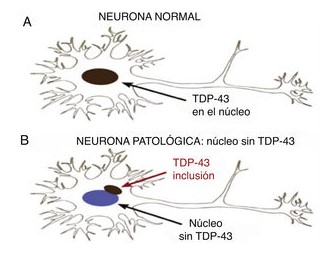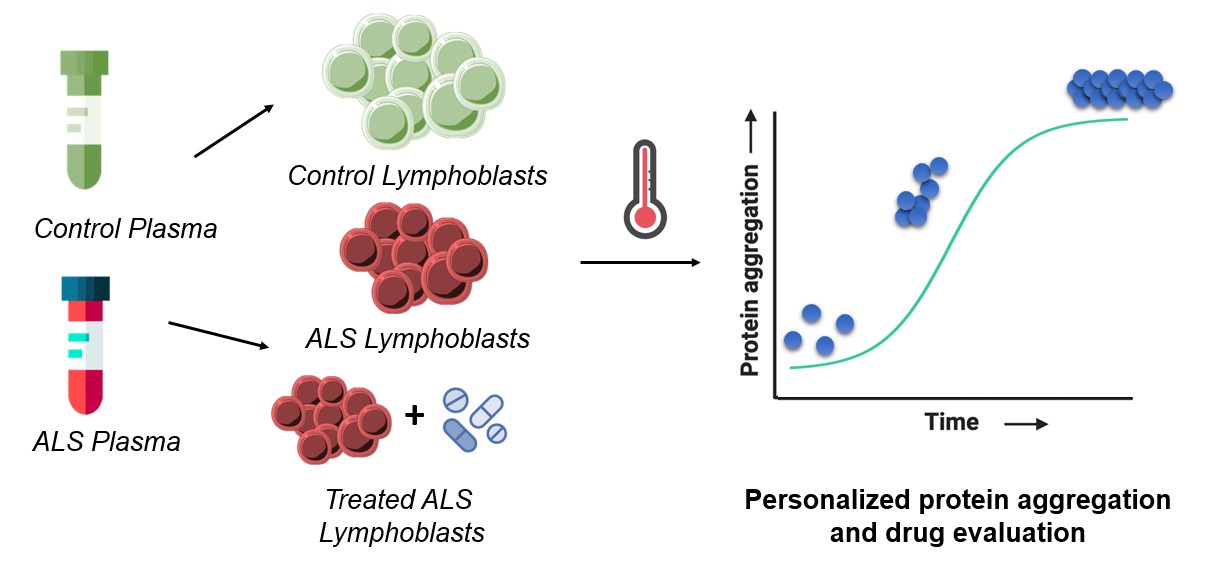Scientists analyze Amyotrophic Lateral Sclerosis patient cells to improve strategy testing
13.05.2025
 |
|
Image: Shutterstock. |
- A study by Dr. Valle Palomo's group at IMDEA Nanociencia offers a strategy against amyotrophic lateral sclerosis (ALS) aimed at personalized medicine.
- Study tests drugs in cell samples derived from ALS patients.
| Tweet | Suscríbase a las notas de prensa |
Madrid, 13th May, 2025. A group of researchers from the IMDEA Nanociencia Institute, the "Margarita Salas" Biological Research Centre, University of Barcelona and the University of Oxford, led by Dr. Valle Palomo, has taken astep towards the development of personalized treatments for amyotrophic lateral sclerosis (ALS), a neurodegenerative disease that, despite years of research, still has no cure or universal effective treatment.
Unlike other pathologies, ALS cannot be reproduced accurately in animal models, complicating the development of effective drugs. Faced with this challenge, Valle's group has opted for an innovative approach: working directly with human cells derived from ALS patients to evaluate drug candidates. In this study, the researchers examined cells derived from ALS patients to better understand how the disease affects them at the molecular level.
The presence of protein aggregates outside the cell nucleus is an abnormal alteration, common in ALS patients. Building on this fact, the team has analysed a collection of lymphocytes – immune cells obtained from the blood – from a total of 18 patients, both sporadic and genetic ALS, as well as healthy people (controls). The team tested a variety of ALS drugs on this broad collection of cells, with the goal of reducing or preventing abnormal protein accumulation outside the cell nucleus.
Specifically, drugs were tested that specifically inhibit a mechanism for regulating protein activity: TDP-43 phosphorylation. TDP-43 is a critical protein for nerve cells, and its pathological form – misfolded and with the formation of protein aggregates – is frequently hyperphosphorylated, that is, with extra phosphate groups.

Image by Jorge Alberto URE (Ref. DOI: 10.1016/j.neuarg.2020.07.001) © 2020. Sociedad Neurológica Argentina
Dr. Palomo's group used specific drugs on the patient derived cells. Some of the compounds, developed by Prof. Martinez from CSIC, inhibit the hyperphosphorylation of TDP-43, and other molecules, developed by Prof. Muñoz-Torrero from Barcelona University, are capable of blocking the formation of protein aggregates in general. Through ultraviolet light absorbance measurements, the team determined the protein aggregation of the samples treated with the different compounds.
 The study has revealed that some compounds reduce protein aggregation in certain patients, while in others they have no effect, and may even worsen it. This result, transferred to the clinic, would mean that not all patients would respond in the same way to the same drugs. The variability of the results obtained reinforces the incipient need to move towards personalized medicine in the treatment of ALS, in the same way that is already done in cancer therapy. "Our goal is to prevent patients from receiving drugs that are not going to be useful to them. As in oncology, we must identify which treatment is the most appropriate for each case," says Valle Palomo.
The study has revealed that some compounds reduce protein aggregation in certain patients, while in others they have no effect, and may even worsen it. This result, transferred to the clinic, would mean that not all patients would respond in the same way to the same drugs. The variability of the results obtained reinforces the incipient need to move towards personalized medicine in the treatment of ALS, in the same way that is already done in cancer therapy. "Our goal is to prevent patients from receiving drugs that are not going to be useful to them. As in oncology, we must identify which treatment is the most appropriate for each case," says Valle Palomo.
In collaboration with Prof. Talbot from the University of Oxford, the researchers also studied motor neurons generated from stem cells of ALS patients with different genetic backgrounds. This method of obtaining and preserving cells, which is currently being developed in Dr. Palomo's laboratory at IMDEA Nanociencia, allows motor neurons of patients to be studied directly in the laboratory and to test different treatments against the disease. Again, the researchers highlight the potential of using patient-specific cell models to find more effective treatments.
The study has been published in the journal ACS Chemical Neuroscience. The results support that direct assessment of the patient's cells prior to treatment could provide key information resulting in a significant increase in the chances of therapeutic success. "It's a less invasive way to look at what's going on in the nervous system," Dr. Valle explains. "Although ALS primarily affects motor neurons, we have seen that lymphocytes also reflect important aspects of the pathology."
ALS is an extremely complex disease. Currently, there are more than 500 clinical trials underway to treat or diagnose ALS, but experts agree that the future lies in a more precise characterization of the molecular profile of each patient.
This study, that has been currently employed with human-derived cells, is not ready for its implementation in the clinical practice. However, it is a step further that demonstrates the utility of personalized evaluation of drugs.
This work is a collaboration between researchers at the Madrid Institute for Advanced Studies in Nanoscience (IMDEA), the "Margarita Salas" Center for Biological Research (CIB-CSIC), the University of Oxford, the University of Barcelona, and the Center for Networked Biomedical Research in Neurodegenerative Diseases (CIBERNED), and has been partially funded by the Severo Ochoa Excellence award to IMDEA Nanociencia (CEX2020-001039-S).
Keywords: amyotrophic lateral sclerosis, als, protein homeostasis, proteostasis, drug treatment, lymphocytes, personalised medicine, neurodegenerative disorder.
Glossary:
- Amyotrophic lateral sclerosis (ALS): A disease of the nervous system that affects neurons in the brain and spinal cord. It originates when the cells of the nervous system degenerate progressively, causing muscle paralysis. The exact cause is not yet known, and in a small number of cases (5%) it is hereditary.
- TDP-43 phosphorylation: aggregation of phosphate groups (PO43-) to the TDP-43 protein. TDP-43 is a protein critical to nerve cell survival. The current consensus is that this protein, misfolded, phosphorylated and/or added to other proteins outside the cell nucleus, in the cytoplasm, is a characteristic of various neurodegenerative disorders, including ALS.
Reference
Proteome Aggregation in Cells Derived from Amyotrophic Lateral Sclerosis Patients for Personalized Drug Evaluation. Carmen Pérez de la Lastra Aranda, Carlota Tosat-Bitrián, Gracia Porras, Ruxandra Dafinca, Diego Muñoz-Torrero, Kevin Talbot, Ángeles Martín-Requero, Ana Martínez, and Valle Palomo. ACS Chemical Neuroscience 2024 15 (21), 3945-3953. DOI: 10.1021/acschemneuro.4c00328
![]() Link to IMDEA Nanociencia Repository: https://hdl.handle.net/20.500.12614/3850
Link to IMDEA Nanociencia Repository: https://hdl.handle.net/20.500.12614/3850
Contact:
Dr. Valle Palomo
valle.palomo (at imdea.org
Biosensors in Neuroscience
Group webpage: https://nanociencia.imdea.org/biosensorsinneuroscience/home
Oficina de Divulgación y Comunicación en IMDEA Nanociencia
divulgacion.nanociencia [at]imdea.org![]()
![]()
![]()
![]()
![]()
Source: IMDEA Nanociencia.
IMDEA Nanociencia Institute is a young interdisciplinary research Centre in Madrid (Spain) dedicated to the exploration of nanoscience and the development of applications of nanotechnology in connection with innovative industries.




